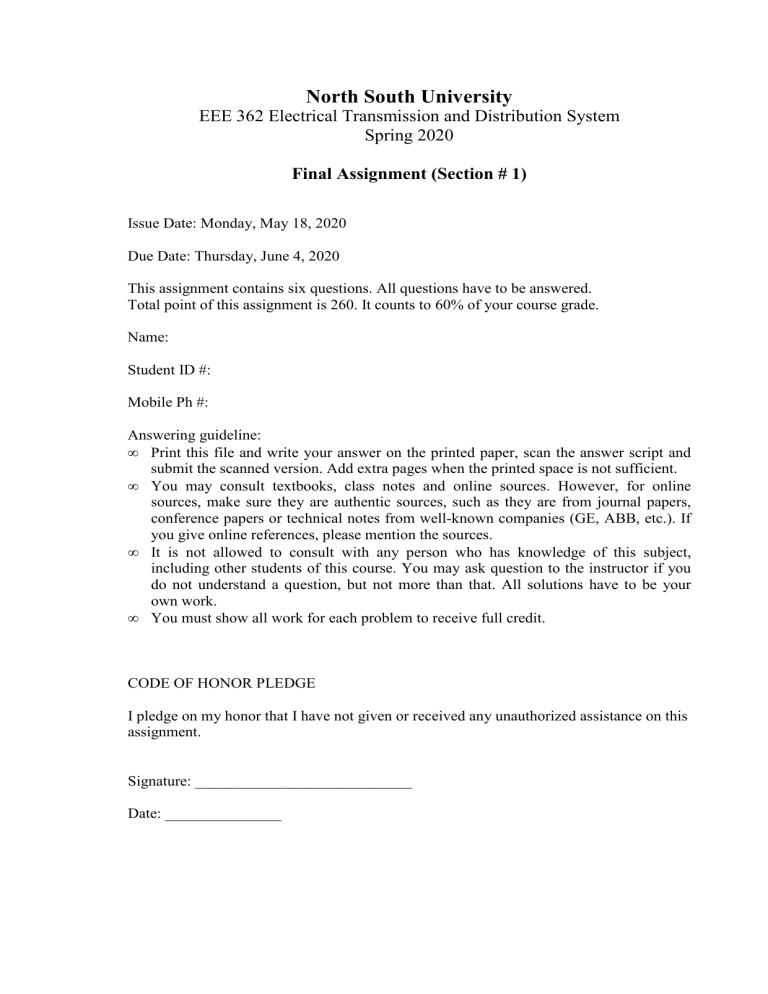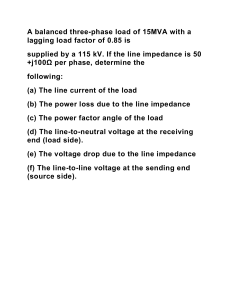Electrical Transmission Assignment: Per-Unit, Power Flow, 3-Phase
advertisement

North South University EEE 362 Electrical Transmission and Distribution System Spring 2020 Final Assignment (Section # 1) Issue Date: Monday, May 18, 2020 Due Date: Thursday, June 4, 2020 This assignment contains six questions. All questions have to be answered. Total point of this assignment is 260. It counts to 60% of your course grade. Name: Student ID #: Mobile Ph #: Answering guideline: • Print this file and write your answer on the printed paper, scan the answer script and submit the scanned version. Add extra pages when the printed space is not sufficient. • You may consult textbooks, class notes and online sources. However, for online sources, make sure they are authentic sources, such as they are from journal papers, conference papers or technical notes from well-known companies (GE, ABB, etc.). If you give online references, please mention the sources. • It is not allowed to consult with any person who has knowledge of this subject, including other students of this course. You may ask question to the instructor if you do not understand a question, but not more than that. All solutions have to be your own work. • You must show all work for each problem to receive full credit. CODE OF HONOR PLEDGE I pledge on my honor that I have not given or received any unauthorized assistance on this assignment. Signature: ____________________________ Date: _______________ 1. Consider a single-phase electric system shown in the following figure. Transformers are rated as follows: X–Y 20 MVA, 13.8/138 kV, leakage reactance 12% Y–Z 20 MVA, 138/69 kV, leakage reactance 15% With the base in circuit Y chosen as 15 MVA, 138 kV, determine the per-unit impedance of the 500 Ω resistive load in circuit Z, referred to circuits Z, Y, and X separately. Neglecting line impedances, draw the impedance diagram of the system in per unit. (5+5+5+10 = 25) 2. Following figure shows the one-line diagram of a three-phase power system. Select system power base 100 MVA and voltage base 25 kV on the generator side. The data are given as follows: G: T1: T2: T3: T4: M: 100 MVA 50 MVA 40 MVA 40 MVA 40 MVA 60 MVA 25 kV 25/220 kV 220/11 kV 25/110 kV 110/11 kV 10.45 kV x = 0.12 per unit x = 0.10 per unit x = 0.15 per unit x = 0.15 per unit x = 0.10 per unit x = 0.2 per unit Lines 1 and 2 have series reactances of 50 Ω and 70 Ω, respectively. At bus 4, the three-phase load (external system) absorbs 70 MVA at 10.45 kV and 0.6 power factor lagging. A three-phase line to ground fault occurs at point F (between bus 4 and the load). Draw a per-unit impedance diagram showing all impedances including the load impedance before fault. After the fault, from the impedance diagram draw Thevenin equivalent circuit step-by-step and find fault current in ampere flowing at point F. (30 + 20 = 50) 3. Consider the following power transmission system: Given, System Base: 100 MVA, 115 kV. Bus 1 is voltage regulated (i.e. generator can adjust bus voltage at the desired value). Bus 2 has a load PL+ jQL and has a switchable capacitor bank jQC. For all operating states, it is desired to maintain the voltage at Bus 2 at V2 =1.0∠00 pu Using circle diagram answer the following questions: a. Operating condition 1: PL = 180 MW; pf = 0.9 lagging. Determine V1∠ δ b. Operating condition 2: Maintain the load power factor at the value of state 1, but increase load’s real power PL = 400 MW. Determine new V1∠δ c. Operating condition 3: The load remains the same as in the state 2. But it is desired to bring down the voltage at Bus 1 to the value of the state 1 by connecting a bank of capacitors in parallel with the load. If the capacitor bank is connected in Y, calculate the value of the capacitance in μF (assume f = 60hz). (25 + 25 + 25) = 75 4. One circuit of a single-phase transmission line is composed of three solid 0.5cm radius wires (conductor X). The return circuit is composed of two solid 2.5cm radius wires (conductor Y). The arrangement of conductors is shown in the following figure. Find the inductance due to the current in each side of the line and the inductance of the complete line in henrys per meter (and in millihenrys per mile). (30) 5. Balanced three-phase voltage of 100 V line to line are applied to a Y-connected load consisting of three resistors. The neutral of the load is not grounded. The resistance in phase a is 15 Ω, in phase b is 25 Ω and in phase c is 40 Ω. Select voltage to neutral of the three-phase line as reference. Draw the circuit diagram and determine the current in phase a and voltage Van. (30) 6. Short Questions (10 x 5 = 50) a. Why 3φ AC system is used in power transmission, why not 1φ, 2φ, 4φ, 5φ, 6φ or any other combination of AC systems? b. Mention four factors to control power flow to the load bus. Why two of these are controllable and the other two are not? c. Suppose you need to transmit 300 MW of power between locations A and B, which are 150 km apart. What level of transmission voltage would you recommend and why? d. Draw a circle diagram and show and explain briefly the different factors that limit maximum power that can be transferred to a load. e. Explain the concept of decomposing an unbalanced system voltage into three sets: positive, negative and zero sequence.

